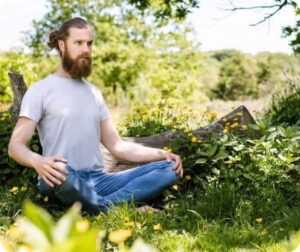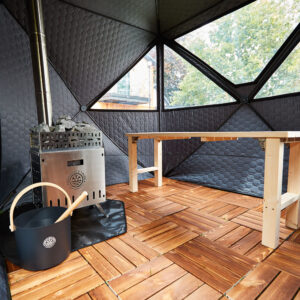
Ice Baths: A Key to Enhanced Recovery and Vitality for Athletes
Explore how ice baths can boost recovery and enhance vitality for athletes. Discover practical tips and insights to elevate your performance. Read more!
Spend Over £500 To Get Free UK Delivery - Excludes Certain Postcodes & Round Ice Baths

In this article, we will explore breathing exercises for anxiety and the positive power of breathwork. Have you ever felt your breath getting shorter, your palms sweatier, and your heart pounding against your chest? If you have, you are not alone. Just in the UK, around 30% of the population experience anxiety, higher-than-ever stress levels, and feelings of panic. And yet, hyperventilation, nervousness, and increased heart rates are nothing more than your body’s response to stress.
Learning to control this “flight-or-fight” response is possible – and can yield exceptional benefits across many aspects of your life. Discover the power of breathwork and relaxation techniques in easing anxiety and managing stress in this Urban Ice Man guide.
In moments of stress and high pressure, it is easy to feel overwhelmed by emotions and feelings. However, when this happens, we lose control over important aspects of our lives which, in turn, can end up contributing to anxiety.
But breath control is not only a powerful stress relief technique. Think of your breath like an “anchor,” a solid pillar that can help you calm down, focus, lower your heart rate and control your actions. Here are just some of the benefits that this practice can bring to your life.
● Breath control is an essential stress management tool – In 2017, a study published on Frontiers of Psychology confirmed that breath control could significantly lower cortisol levels in the blood, thus quickly lowering stress levels.
● Over time, slower and deeper breathing can lower blood pressure – around 14 million adults in the UK suffer from high blood pressure, which, if left untreated, can lead to a range of disorders, including heart failure and kidney disease. According to studies conducted in 2001 and 2015, practising conscious breathing for 10 minutes a day can lower blood pressure.
● It can help ease symptoms of depression – according to recent research, practising yoga and meditative breathing techniques for 12 weeks can help reduce the symptoms of depression.
● It is essential to improve focus and concentration – by balancing a natural chemical in the brain (noradrenaline), breathwork can boost focus and attention while reducing fatigue.
● It helps with pain and chronic pain management – deep breathing promotes healthy blood flow and toxin elimination, which can ease pain and chronic pain. Controlling the breath can also help better manage pain.
Breathing is supposed to be the easiest and most natural thing we do at any given time. Every time we breathe in air, oxygen is delivered to blood cells and carbon dioxide, a waste product, is released and carried out by our exhales. It’s as simple as that. But controlling this flow is another skill entirely, and conscious breathing can have endless benefits. Developing breath control through breathing exercises and becoming connected with your breath can have tremendous benefits.
When we are anxious, we are naturally prone to take more rapid inhales – or chest breathing. These short inhales stimulate the sympathetic nervous system, which is responsible for the famous “fight-or-flight” response or acute stress response.
Additionally, improper and shallow breathing can disrupt the exchange of oxygen and carbon dioxide. In turn, this can worsen anxiety, fatigue, panic attacks, increased heart rate, dizziness, muscle tension, and fatigue. Shallow breaths are typically not ideal and can fan the flames of anxiety and stress.
The opposite to shallow chest breathing is diaphragmatic breathing (also known as deep breathing). To calm ourselves down, we often focus on lengthening our inhale, while it is the exhale that we should focus on. Deep belly breathing, paired with longer exhales, stimulate the parasympathetic nervous system, which regulates the heartbeat, breathing, digestion, and blood flow. Deep breathing can be a gateway to breathing properly and enables us to become more connected to our breath and develop an awareness of how deep breath feels, exploring abdominal breathing or belly breathing rather than breathing from the upper chest is a great place to start. Breathing exercises enable you to build awareness and develop breathing techniques.
Now that you know what happens in your body every time you breathe, let’s look at how breathing exercises for anxiety can help you lower levels of stress and reduce anxiety, avoid the naturally-occurring acute stress response, and find a more level mental state.
You can begin with exploring your body and your breath, being by taking a normal breath and tuning your mind to how that feels, gently breath and focusing on your body. Inhale slowly and make sure not to take rapid breaths. Explore how it feels when you gently breathe and inhale quietly. Keep your shoulders relaxed and completely exhale, but don’t exhale forcefully. Inhale slowly and deeply, keep your jaw relaxed, breathe slowly and connect with how your body feels. There should be a calming focus with slow breathing, where the action is more conscious and intentional than normal breathing. This is not a breathing exercise per se but more an exploration of breath and respiratory function, that will begin to provide a relaxation response as you interrupt your normal breathing pattern and prime the body for more specific and purposeful breathing exercises.
simple breathing technique
Also known as simhasana in Sanskrit, Lion’s Breath is a common technique practised in yoga. In particular, Lion’s Breath can help you relax the muscles of your face and jaw, while also reducing feelings of stress and anxiety. When practised regularly, it may also regulate cardiovascular functions.
Here’s how to practice Lion’s Breath:
● Start in a comfortable seated position, position your hands on your knees, and slightly lean forward.
● Inhale through the nose
● Exhale by opening your mouth wide, sticking out your tongue and stretching it towards the chin (think about what a roaring lion looks like!)
● Take a few normal breaths and repeat lion’s breath for up to seven times
Another breathing technique practised in yoga is alternate-nostril breathing – or Nadi shodhana in Sanskrit. This technique requires you to close off one nostril at a time and alternate between nostrils.
Here’s how to practise alternate-nostril breathing:
● Start in a comfortable seated position.
● Get your hand ready by bending your pointer and middle finger towards the palm. Your thumb, ring finger, and pinky will remain extended.
● Take a few normal breaths to focus
● Use your thumb to close your right nostril and inhale through the left nostril
● Close the left nostril by using the ring finger while opening the right nostril.
● Exhale and then inhale through the right nostril
● Close off the right nostril and exhale through the left
● Repeat ten times before releasing both nostrils
Belly breathing can be practised for 20-30 minutes each day, even just before bedtime.
● Find a comfortable position, either seated or lying down
● Place one hand on your belly, and the other on your chest
● Relax your body, noticing if there are areas of tensions
● Breathe through the nose into your belly, so you should feel your belly rise
● Exhale slowly through the mouth
Some call this “teddy bear breathing” because it can be practised by placing a teddy bear on your belly. The hand on your chest shouldn’t rise when breathing.
Box breathing – or four-square breathing – is a type of rhythmic breathing that is simple to learn and highly beneficial:
● Practice while comfortably seated or lying down
● Exhale to a count of four
● Hold for four
● Inhale for four
● Hold are in for four
● Repeat
Developed by Dr Andrew Weil, the 4-7-8 breathing technique – or Relaxing Breath – is similar to box breathing, but it places a greater focus on the exhale. And, as we know, lengthening the exhale can immediately relieve stress and tranquillise the nervous system!
● Begin seated or lying down. Exhale completely
● Place your tongue at the top edge of your front teeth
● Inhale through the nose to a count of four
● Hold your lungs empty to a count of seven
● Exhale through the mouth to a count of eight
Unlike some of the techniques seen above, pursed-lip breathing can be practised everywhere and at any time. Without disrupting your breath pattern, pursed-lip breathing can help you deepen your breathing and make it more intentional.
● Sit in a comfortable position
● Inhale through the nose at a count of two
● Exhale through the mouth to a count of four, while puckering your lips / maintaining pursed lips
● Practice for at least five times
Mindfulness meditation – including guided meditation sessions and body scans – can help you focus on your breathing, increase awareness of the present moment, and improve your stress response.
Because we are all subjected to bad breathing habits, you might need to re-learn how to breathe to better manage stress and anxiety. Through home practise, guided meditation, and personalised sessions, you can turn your breath into your most powerful ally to live a healthy, calm life.
Book a breathwork session with Urban Ice Man: https://calendly.com/ryanabbott

Founder of Urban Ice Tribe

Explore how ice baths can boost recovery and enhance vitality for athletes. Discover practical tips and insights to elevate your performance. Read more!

There’s nothing quite like the raw, elemental power of a pop-up sauna. Portable, authentic, and deeply restorative, it’s the perfect way to reconnect with nature and yourself. But to take your sauna ritual to the next level, the right sauna accessories can make all the difference.

Transform your outdoor space into a personal wellness retreat with the Urban Ice Tribe Sauna Tent. This detailed setup guide walks you through every step, from unboxing to your first steam session, blending practical instruction with the mindful ritual of heat therapy.
Helping men & women release anxieties & limiting beliefs to experience a life of freedom using powerful breathwork, cold water therapy, movement & sound healing.

No spam, notifications only about new products, updates, offers and announcements.